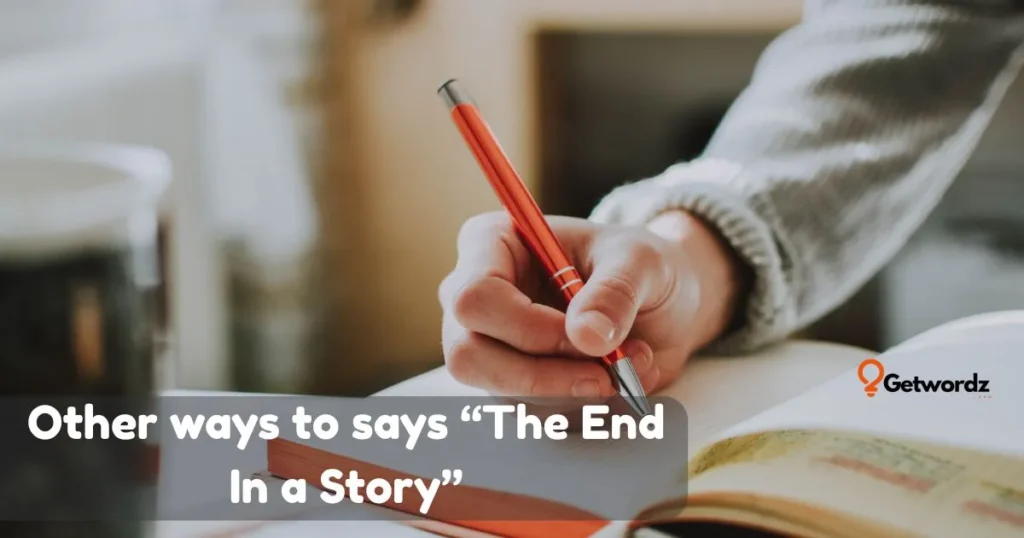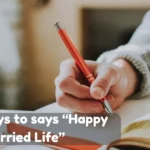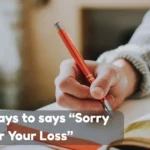“The End in a Story” often marks the final moment when every thread of a narrative comes together, signaling closure, reflection, or a new beginning. It’s the phrase we instinctively write or say to conclude a tale, whether it’s a heartfelt letter, a creative essay, or a bedtime story.
But when you use “The End” too often, it can start to feel predictable, even cliché, especially for writers, students, or storytellers seeking a more impactful finish. That’s exactly why so many people search for different ways to say “The End in a story.”
Whether you’re crafting a short story for class, wrapping up a novel, sending a sentimental message to a partner, or adding a witty note to a post shared with friends or colleagues, finding the right closing words can make all the difference.
In this post, I’ll share creative alternatives, unique expressions, and better word choices that give your story ending more personality and emotional depth. Think of it as a writer’s toolkit for expressing closure, whether you want something poetic, funny, dramatic, or deeply meaningful.
Ready to discover how to say “The End” in ways that truly stand out? Let’s explore.
1. And So It Ends
Scenario: You’ve just finished telling a story filled with twists and emotions. As the final moment arrives, you say, “And so it ends,” giving your audience a sense of calm and closure.
Explanation: This phrase is a thoughtful and poetic alternative to “The End in a story.” It has a reflective tone that works well for emotional or dramatic endings, especially in novels or speeches.
Examples:
- “And so it ends, the tale of two hearts that never stopped believing.”
- “And so it ends quietly, just as it began.”
- “And so it ends, with a smile that says everything left unsaid.”
Why It Works:
It feels elegant and timeless, perfect for writers who want a soft, memorable conclusion instead of the plain “The End.”
2. The Final Chapter
Scenario: You’re closing a book or wrapping up a personal story on social media. Saying “The final chapter” makes your ending feel literary and complete.
Explanation: A creative alternative to “The End,” this phrase works especially well in storytelling or life reflections, symbolizing both closure and transition.
Examples:
- “This is the final chapter of our journey together.”
- “Every ending is just the final chapter before a new beginning.”
- “I’ve reached the final chapter, and it feels just right.”
Why It Works:
It gives your story emotional weight and signals that something meaningful has come full circle.
3. To Be Continued
Scenario: You’re ending a piece of writing or video but want your audience to expect more.
Explanation: This fun and suspenseful alternative keeps curiosity alive. It’s perfect for serial content, storytelling blogs, or creative writing.
Examples:
- “And that’s where I’ll stop… to be continued.”
- “This story isn’t over yet , to be continued.”
- “Stay tuned; this chapter closes, but it’s to be continued.”
Why It Works:
It adds intrigue and engagement, ideal for storytellers who like to leave readers hanging.
4. The Story Lives On
Scenario: You’re ending a motivational piece or a tribute post.
Explanation: This inspirational alternative to “The End in a story” conveys hope and continuity. It’s ideal for family tributes, biographies, or personal blogs.
Examples:
- “Though this part closes, the story lives on.”
- “The story lives on in every memory we share.”
- “Endings are temporary, the story lives on.”
Why It Works:
It transforms an ending into something uplifting and eternal, resonating deeply with readers.
5. Until Next Time
Scenario: You’re signing off from a blog, vlog, or journal entry and want to sound friendly yet conclusive.
Explanation: This casual, modern alternative to “The End” feels personal and engaging, great for digital storytellers.
Examples:
- “That’s all for today’s story until next time!”
- “Until next time, may your journey continue beautifully.”
- “It’s not goodbye, just until next time.”
Why It Works:
It creates connection and leaves readers anticipating your next post or story.
Read more: 30 Other Ways To Say “Happy Married Life” With Examples!
6. The Curtain Falls
Scenario: You’re finishing a dramatic story or performance-themed piece.
Explanation: This classic and artistic expression symbolizes closure with grace. It’s perfect for theater-related stories or creative writing.
Examples:
- “The curtain falls, and the audience holds its breath.”
- “With a final bow, the curtain falls on our story.”
- “The curtain falls, but the memory remains.”
Why It Works:
It gives your ending a cinematic flair while preserving elegance and mystery.
7. The Journey Ends Here
Scenario: You’re wrapping up a travel blog, memoir, or emotional narrative.
Explanation: A simple yet powerful alternative to “The End,” this phrase feels grounded and sincere.
Examples:
- “The journey ends here, but the memories will stay forever.”
- “And just like that, the journey ends here.”
- “Our story has been beautiful and the journey ends here.”
Why It Works:
It evokes closure and fulfillment, ideal for reflective writing.
8. The Rest Is Silence
Scenario: You’re ending a thoughtful, melancholic story or poem.
Explanation: This philosophical alternative (borrowed from Shakespeare) suggests peace and finality.
Examples:
- “After all the words, the rest is silence.”
- “He smiled one last time the rest is silence.”
- “When love has spoken, the rest is silence.”
Why It Works:
It feels literary and emotionally rich, perfect for deep storytelling.
9. And That’s How It Ends
Scenario: You’re finishing a lighthearted tale or conversation.
Explanation: This casual alternative to “The End” works well for friendly or humorous storytelling.
Examples:
- “And that’s how it ends with a laugh and a lesson.”
- “And that’s how it ends, in the most unexpected way.”
- “And that’s how it ends, simple, sweet, and true.”
Why It Works:
It keeps the tone conversational, relatable, and fun.
10. The End… Or Is It?
Scenario: You’re finishing a suspense story or playful narrative.
Explanation: This witty and mysterious twist on “The End” leaves readers guessing.
Examples:
- “The End… or is it?”
- “They thought it was over The End… or is it?”
- “Every ending hides a new beginning. The End… or is it?”
Why It Works:
It builds curiosity and engagement, great for modern storytelling.
11. And That’s a Wrap
Scenario: You’ve finished a creative project, short film, or blog series and want to end it on a fun, upbeat note.
Explanation: This is a casual and energetic alternative to “The End in a story.” Common in film and content creation, it gives a friendly, celebratory vibe.
Examples:
- “And that’s a wrap on our summer adventure!”
- “After months of writing, that’s a wrap!”
- “And that’s a wrap. Thank you all for being part of the journey.”
Why It Works:
It feels modern and relatable, making your story ending sound cheerful, confident, and satisfying.
12. The End of an Era
Scenario: You’re reflecting on a significant change finishing school, leaving a job, or closing a life chapter.
Explanation: This emotional and reflective alternative captures the weight of big transitions. It’s great for memoirs, personal essays, or heartfelt social posts.
Examples:
- “Today truly marks the end of an era.”
- “The end of an era, but the memories will last forever.”
- “It’s bittersweet the end of an era, and the start of something new.”
Why It Works:
It adds emotional depth and helps readers connect to the sense of nostalgia and growth behind every ending.
13. Here Lies the Story
Scenario: You’re closing a dark, mysterious, or gothic tale.
Explanation: This dramatic and literary expression works beautifully for stories with somber or reflective tones. It’s a creative alternative to “The End” that evokes finality with style.
Examples:
- “Here lies the story of a heart that never gave up.”
- “Here lies the story, resting peacefully at last.”
- “Here lies the story, tragic, tender, and true.”
Why It Works:
It gives your conclusion poetic gravity and an unforgettable emotional impact.
14. The Tale Comes to a Close
Scenario: You’re writing a fantasy, fable, or folklore-inspired story.
Explanation: This formal yet elegant phrasing makes the ending feel traditional and classic, ideal for narrative or historical pieces.
Examples:
- “And with that, the tale comes to a close.”
- “The tale comes to a close, but the lesson remains.”
- “The tale comes to a close softly, beautifully, completely.”
Why It Works:
It fits perfectly for timeless stories and adds a storyteller’s touch that honors tradition.
15. The Story Finds Its End
Scenario: You’re finishing a reflective or emotional narrative.
Explanation: A gentle, poetic alternative that focuses on the story’s natural conclusion rather than an abrupt stop.
Examples:
- “The story finds its end, and peace settles in.”
- “The story finds its end, just as it was meant to.”
- “In the quiet after the storm, the story finds its end.”
Why It Works:
It feels smooth and intentional, giving your ending emotional harmony and closure.
Read more: 30 Other Ways To Say “Happy To Hear That” With Examples!
16. Closing the Chapter
Scenario: You’re ending one phase of life or wrapping up a personal growth story.
Explanation: This versatile and positive phrase symbolizes progress and moving forward, making it great for personal or motivational writing.
Examples:
- “Closing the chapter on this beautiful journey.”
- “It’s time for closing the chapter and starting anew.”
- “Closing the chapter doesn’t mean the story’s over.”
Why It Works:
It offers closure with optimism, reminding readers that every ending leads to a new beginning.
17. The Lights Dim
Scenario: You’re ending a story set on stage, in cinema, or with emotional ambiance.
Explanation: This cinematic alternative to “The End” creates atmosphere and emotion, perfect for dramatic writing or scripts.
Examples:
- “The lights dim, and silence fills the room.”
- “As the lights dim, the story fades into memory.”
- “The lights dim on a tale well told.”
Why It Works:
It paints a visual image and gives your conclusion a graceful, almost film-like exit.
18. All Good Things Must End
Scenario: You’re finishing something joyful or meaningful, like a friendship story or travel diary.
Explanation: This classic proverb-like expression offers wisdom and acceptance, ideal for heartfelt narratives.
Examples:
- “All good things must end, but the joy remains.”
- “All good things must end, that’s what makes them special.”
- “It’s true, all good things must end someday.”
Why It Works:
It feels universal and comforting, giving readers emotional closure without sadness.
19. The Page Turns
Scenario: You’re finishing a chapter of life, symbolizing change or growth.
Explanation: A literary and inspiring alternative that suggests evolution instead of finality.
Examples:
- “The page turns, and a new adventure begins.”
- “With gratitude, the page turns on this beautiful story.”
- “The page turns softly, steadily, surely.”
Why It Works:
It keeps the momentum of storytelling alive and offers a sense of progress.
20. Here’s Where It Ends
Scenario: You’re writing a direct, grounded story or journal entry.
Explanation: This modern and simple expression suits personal essays, blog posts, or realistic fiction.
Examples:
- “Here’s where it ends for now.”
- “Here’s where it ends, and I’m okay with that.”
- “Here’s where it ends, not with tears but with peace.”
Why It Works:
It sounds natural, relatable, and human, fitting perfectly in authentic writing styles.
Read more: 30 Other Ways To Say “Save The Date” With Examples!
21. Until We Meet Again
Scenario: You’re ending a romantic or emotional story where parting feels temporary.
Explanation: This warm and hopeful alternative to “The End” conveys affection and optimism.
Examples:
- “Until we meet again, my heart remains with you.”
- “It’s not goodbye just until we meet again.”
- “Until we meet again, the story waits.”
Why It Works:
It expresses longing and connection, leaving readers with heartfelt anticipation.
22. The Circle Closes
Scenario: You’re ending a story that feels complete, symbolic, or spiritual.
Explanation: This symbolic expression represents wholeness and destiny, ideal for reflective or philosophical writing.
Examples:
- “The circle closes, and everything finds its place.”
- “And as the circle closes, peace returns.”
- “The circle closes where it once began.”
Why It Works:
It adds meaning and symmetry, making your ending feel profound and purposeful.
23. The Chapter Ends
Scenario: You’re summarizing a life phase or emotional journey.
Explanation: This balanced and versatile phrase is perfect for storytelling that mirrors real life or growth.
Examples:
- “The chapter ends, and I turn the page with gratitude.”
- “The chapter ends here, but the story isn’t over.”
- “The chapter ends, softly and beautifully.”
Why It Works:
It’s simple yet poetic, fitting any tone reflective, emotional, or inspirational.
24. The Curtain Closes
Scenario: You’re finishing a creative piece or performance-related narrative.
Explanation: A classic theatrical alternative that symbolizes finality and applause.
Examples:
- “The curtain closes on a story worth remembering.”
- “As the curtain closes, we smile through the tears.”
- “The curtain closes gracefully, finally.”
Why It Works:
It delivers a sense of completion and artistic flair, perfect for storytelling blogs or scripts.
25. The Last Line
Scenario: You’re emphasizing a strong, meaningful conclusion.
Explanation: This metaphorical and minimal phrase draws attention to your final thought or moral.
Examples:
- “And this is the last line, the truth of it all.”
- “The last line is written, but the message lives on.”
- “With this last line, the heart finds peace.”
Why It Works:
It highlights finality in a creative way, perfect for writers who value simplicity and emotion.
Read more: 30 Other Ways To Say “Pretty” With Examples!
26. The Story Ends Here
Scenario: You’re ending a fiction piece or personal anecdote with direct honesty.
Explanation: This straightforward alternative delivers closure without drama.
Examples:
- “The story ends here, just as it should.”
- “The story ends here, where everything began.”
- “The story ends here, but its echoes will stay.”
Why It Works:
It’s clean, clear, and confident, a simple statement that still feels powerful.
27. Happily Ever After
Scenario: You’re finishing a love story or family tale.
Explanation: This classic fairy-tale ending expresses joy, peace, and satisfaction.
Examples:
- “And they lived happily ever after.”
- “Happily ever after that’s how our story ends.”
- “Every story deserves its happily ever after.”
Why It Works:
It’s timeless, comforting, and instantly recognizable ideal for positive, romantic conclusions.
28. The End of the Line
Scenario: You’re wrapping up a tough or realistic narrative.
Explanation: This gritty and straightforward phrase adds authenticity, great for dramas or memoirs.
Examples:
- “This is the end of the line for us.”
- “At the end of the line, I finally found myself.”
- “The end of the line, but not the end of hope.”
Why It Works:
It’s grounded and human, perfect for emotionally raw or realistic stories.
29. The Rest Is History
Scenario: You’re concluding a success story or milestone achievement.
Explanation: This popular idiom works as a confident, upbeat way to summarize something remarkable.
Examples:
- “We met, we built, and the rest is history.”
- “The rest is history and a beautiful one at that.”
- “From small beginnings to great success the rest is history.”
Why It Works:
It adds flair and confidence, perfect for storytelling with a triumphant tone.
30. The End Is Just the Beginning
Scenario: You’re closing with a motivational or inspirational message.
Explanation: This powerful and uplifting alternative reframes endings as new opportunities.
Examples:
- “The end is just the beginning of something greater.”
- “Every story ends, but the end is just the beginning.”
- “Remember, the end is just the beginning, keep going.”
Why It Works:
It leaves readers inspired and hopeful, making your conclusion memorable and emotionally rich.
✅ Pros and cons of Using “The End in a Story”
pros
- ✅ Universal recognition: The phrase is instantly understood by readers of all ages and cultures, making it timeless and relatable.
- ✅ Strong keyword relevance: “The End in a Story” has excellent SEO potential because it directly matches what writers and readers search for online.
- ✅ Emotional closure: It gives a satisfying sense of completion, ideal for storytelling, essays, and creative writing.
- ✅ Easy to use in multiple contexts: Works for books, blogs, social media captions, and even short films.
- ✅ Supports creative variety: Encourages writers to explore different ways to say “The End”, boosting engagement and originality.
Cons❌
- ❌ Overused expression: The phrase can feel cliché or outdated if used too often without variation.
- ❌ Limited creativity: It may lack uniqueness in modern or innovative storytelling formats.
- ❌ Weak emotional impact: Sometimes “The End” doesn’t fully capture the tone or mood of a powerful conclusion.
- ❌ Less suitable for digital writing: In online storytelling or social media posts, it can seem abrupt or old-fashioned.
- ❌ SEO competition: Because it’s a common keyword, ranking high in search results may require extra optimization and unique content angles.
Closing words
The End in a Story isn’t just about closing a chapter, it’s about leaving a lasting impression. Throughout this post, we explored fresh alternatives, creative expressions, and meaningful ways to replace overused endings.
These ideas help writers, students, and storytellers bring emotion, originality, and purpose to their final lines. You can use these unique expressions in different contexts, whether you’re finishing a short story for class, ending a heartfelt letter to a friend, writing a caption on social media, or signing off a professional piece.
Each phrase offers different ways to say “The End” with more character and style. Try one of these creative alternatives in your next story or message and see how it transforms the tone. Choosing expressive wording shows authenticity and confidence in your writing.
A thoughtful closing always matters, and with these ideas, The End in a Story will never feel ordinary again.




